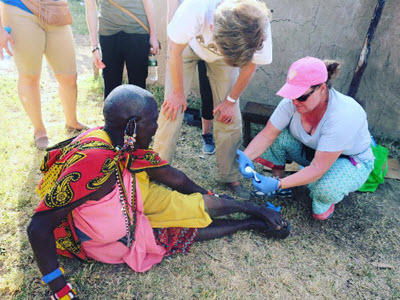Featured
Tags
Share

As the United States grows more diverse, cultural knowledge and strengthened communication skills can aid healthcare providers in improving patient comfort and satisfaction with care.
The U.S. Census Bureau projects that more than half of all Americans are expected to belong to a minority group by 2044. According to the same report, nearly one in five people in the U.S. will be foreign-born by 2060.
Faculty members from Chamberlain College of Nursing recently shared five ways nurses can provide more culturally congruent care:
1. Be Curious
The continuum of cultural competency starts with exposing yourself to different cultures, says Sheri Sawchuk, MSN, RN, an assistant professor at Chamberlain.
Through the Global Health Education Program at Chamberlain, Sawchuk leads students on trips to serve communities in Haiti, Kenya and beyond. Over the course of two weeks, students care for patients, make home visits, experience the culture first-hand and gain a new perspective on their own beliefs and culture.
While this experience allows for a “larger than life” cultural immersion, becoming more culturally competent can happen anywhere with a little bit of effort, Sawchuk says.
“The first thing is to be curious and to purposefully create cultural encounters,” she said. “Go to a cultural event in your community. If you’re in the hospital and someone is speaking a different language, go try to communicate with them.”
2. Do Your Homework
Research can provide a foundation for cultural understanding and can happen through books, movies, readings, trainings or talking with people. Learn more about cultural topics like gender relations, customs, nonverbal cues, religious beliefs, views on health issues, dietary restrictions and more.
“When I have patients from different cultures, I like to have a conversation with them and really get to know them as an individual,” said Veronica Vital, PhD, RN, assistant professor and coordinator of the Bachelor of Science in Nursing (BSN) Concentration in Serving Hispanic Communities at Chamberlain. “I ask questions – what is your culture like? What are your beliefs? I seek to understand, and then when I have a patient from the same culture in the future, I am able to provide better care for them.”
Dr. Vital says it’s also important to keep in mind that many cultures have subcultures – and to avoid generalizing a population. For instance, the beliefs and cultures of Puerto Ricans, Cubans and Mexicans vary considerably, although they are all a part of the larger Hispanic community.
3. Account for Sociocultural Aspects of Health
Seek to understand the social and cultural factors that might affect an individual’s health and incorporate these factors into your care where possible. These might include how individuals think about health issues, their behaviors and habits, economic issues and more.
“When a nurse understands the culture of their patient, they can implement a culturally competent care regimen,” Dr. Vital said. “For instance, incorporating the culture’s foods may make a patient more likely to comply with what is being prescribed.”
On a recent trip to Haiti, Chamberlain students spent a five-hour shift in the local hospital working alongside Haitian nurses to get a fuller picture of the sociocultural aspects of health.
“We wanted students to see that in developing countries, going to the hospital isn’t often a quick fix,” Sawchuk said. “Patients might not be able to afford medications or receive the same level of care we get in the hospital. It becomes even more important to educate patients and their families on how to better care for themselves in these communities.”
4. Ensure Understanding
When determining if a patient understands English, be sure not to jump to any conclusions, says Dr. Vital.
“It’s very important for nurses to know that individuals sometimes revert to their primary language in times of stress,” she said. “They may speak English and they’re just not speaking it while their families are present. It’s important not to assume language. Always, always ask the patient and include them before making assumptions.”
A simple way to ensure a patient has comprehended is to ask them to repeat back to you, Dr. Vital said. And always keep in mind that certain terminology may not be easily translated or understood – particularly figures of speech.
5. Find Ways to Connect
Building trust with a patient is essential to a nurse’s work, but can feel more challenging when there is a language barrier. When working with a translator, it can be tempting to look at and speak directly with the interpreter, Sawchuk said. During Chamberlain’s international trips, clinic stations are set up so that the nurse is looking directly at the patient and the interpreter is off to the side.
“We coach our students to look at the patient while they’re speaking, and not the translator,” she said. “Our students listen and still do all the gestures, like nodding, or a touch on the shoulder or the knee if that’s appropriate in the culture. It’s a way to let the patient know that they’re connected directly to them and that the interpreter is just saying the words.”
And regardless of culture, other ways of connecting with a patient all still apply – including listening, asking questions, seeking to understand and following through.
By Molly Mattison
More from Home
Request More Information
To receive the Chamberlain University Program Guide, including associated career paths, please select a program of study.






